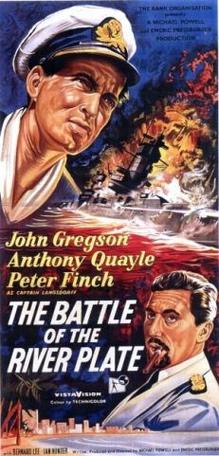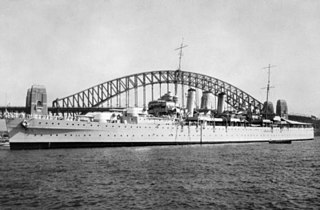
The Battle of the River Plate was fought in the South Atlantic on 13 December 1939 as the first naval battle of the Second World War. The Kriegsmarine heavy cruiser Admiral Graf Spee, commanded by Captain Hans Langsdorff, engaged a Royal Navy squadron, commanded by Commodore Henry Harwood, comprising the light cruisers HMS Ajax, HMS Achilles and the heavy cruiser HMS Exeter.

An armed merchantman is a merchant ship equipped with guns, usually for defensive purposes, either by design or after the fact. In the days of sail, piracy and privateers, many merchantmen would be routinely armed, especially those engaging in long distance and high value trade.

HMNZS Achilles was a Leander-class light cruiser, the second of five in the class. She served in the Royal New Zealand Navy in the Second World War. She was launched in 1931 for the Royal Navy, loaned to New Zealand in 1936 and transferred to the new Royal New Zealand Navy in 1941. She became famous for her part in the Battle of the River Plate, alongside HMS Ajax and HMS Exeter and notable for being the first Royal Navy cruiser to have fire control radar, with the installation of the New Zealand-made SS1 fire-control radar in June 1940.

The Battle of the River Plate is a 1956 British war film in Technicolor and VistaVision by the writer-director-producer team of Michael Powell and Emeric Pressburger. The film stars John Gregson, Anthony Quayle, Bernard Lee and Peter Finch. It was distributed worldwide by Rank Film Distributors Ltd.

The Battle of the Falkland Islands was a First World War naval action between the British Royal Navy and Imperial German Navy on 8 December 1914 in the South Atlantic. The British, after their defeat at the Battle of Coronel on 1 November, sent a large force to track down and destroy the German cruiser squadron. The battle is commemorated every year on 8 December in the Falkland Islands as a public holiday.

HMS Dorsetshire was a County-class heavy cruiser of the British Royal Navy, named after the English county, now usually known as Dorset. The ship was a member of the Norfolk sub-class, of which Norfolk was the only other unit; the County class comprised a further eleven ships in two other sub-classes. Dorsetshire was built at the Portsmouth Dockyard; her keel was laid in September 1927, she was launched in January 1929, and was completed in September 1930. Dorsetshire was armed with a main battery of eight 8 in (200 mm) guns, and had a top speed of 31.5 knots.

HMS Ajax was a Leander-class light cruiser which served with the Royal Navy during World War II. She became famous for her part in the Battle of the River Plate, the Battle of Crete, the Battle of Malta and as a supply escort in the siege of Tobruk. This ship was the eighth in the Royal Navy to bear the name. In February 1942, she was adopted by the civil community of Halifax.

RMS Alcantara was a Royal Mail Lines ocean liner that was built in Belfast in 1926. She served in the Second World War first as an armed merchant cruiser and then a troop ship. She returned to civilian service in 1948 and was scrapped in 1958.

HMS Cumberland was a County-class heavy cruiser of the Royal Navy that saw action during the Second World War.
Thor was an auxiliary cruiser of Nazi Germany's Kriegsmarine in World War II, intended for service as a commerce raider. Also known to the Kriegsmarine as Schiff 10; to the Royal Navy she was Raider E. She was named after the Germanic deity Thor.

HMAS Westralia (F95/C61) was an auxiliary cruiser of the Royal Australian Navy (RAN). Built by Scottish shipbuilder Harland and Wolff and completed in 1929, Westralia was operated by the Huddart Parker company until 1939, when she was requisitioned for service with the RAN as an Armed Merchant Cruiser (AMC). Fitted with guns and commissioned in early 1940, Westralia was initially used to escort convoys in the Pacific and Indian oceans. In November 1940, the largest mutiny in RAN history occurred aboard the ship, with 104 men charged.

SS Cap Trafalgar was a German ocean liner launched in 1913 for the Hamburg Süd line. In 1914, she was converted for use as an auxiliary cruiser during World War I. She was the first armed merchant cruiser sunk by a ship of the same class; she was destroyed by HMS Carmania, also a converted ocean liner, in a furious action in the South Atlantic in September 1914. It was the world's first battle between former ocean liners.

The first RMS Windsor Castle, along with her sister, RMS Arundel Castle, was an ocean liner laid down by the Union-Castle Line for service from the United Kingdom to South Africa. During World War 2 the Windsor Castle was requisitioned as a troopship and on 23 March 1943 was sunk by an aerial torpedo off the coast of Algeria.

Germany–Uruguay relations are foreign relations between Germany and Uruguay. Germany has an embassy in Montevideo. Uruguay has an embassy in Berlin, a consulate-general in Hamburg and 6 honorary consulates. Germany is Uruguay's principal trading partner in the European Union.

The action of 4 April 1941 was a naval engagement fought during the Battle of the Atlantic during the Second World War. A German commerce raider, Thor, encountered the British armed merchant cruiser HMS Voltaire and sank it after a short engagement. The German crew rescued the British survivors, some of whom were repatriated and gave an account to the Admiralty. It was accepted that German commerce raiders were too well-armed for converted ocean liners equipped with obsolete guns but nothing else was available to the Royal Navy until later in the war.

Admiral Graf Spee was a Deutschland-class "Panzerschiff", nicknamed a "pocket battleship" by the British, which served with the Kriegsmarine of Nazi Germany during World War II. The vessel was named after World War I Admiral Maximilian von Spee, commander of the East Asia Squadron who fought the battles of Coronel and the Falkland Islands, where he was killed in action. She was laid down at the Reichsmarinewerft shipyard in Wilhelmshaven in October 1932 and completed by January 1936. The ship was nominally under the 10,000 long tons (10,000 t) limitation on warship size imposed by the Treaty of Versailles, though with a full load displacement of 16,020 long tons (16,280 t), she significantly exceeded it. Armed with six 28 cm (11 in) guns in two triple gun turrets, Admiral Graf Spee and her sisters were designed to outgun any cruiser fast enough to catch them. Their top speed of 28 knots left only the few battlecruisers in the Anglo-French navies fast enough and powerful enough to sink them.

Uruguay remained neutral for most of World War II. The policy of President Alfredo Baldomir, leading the Colorado Party, was to support the Allied cause, but from a neutral base. Great Britain retained considerable influence with the Baldomir regime, largely through the efforts of Sir Eugen Millington-Drake, who was the British Minister in Montevideo from 1934 to 1941. In January 1942, Baldomir terminated diplomatic relations with the Axis powers. He resigned in 1943 and his neutrality policy was continued by his successor Juan José de Amézaga, also of the Colorado Party. In February 1945, having signed the Declaration by United Nations, Amézaga declared war on Germany and Japan.

RMS Asturias was a Royal Mail Lines ocean liner that was built in Belfast in 1925. She served in the Second World War as an armed merchant cruiser until she was crippled by a torpedo in 1943. She was out of action until 1948 when she returned to civilian service as an emigrant ship. She became a troop ship in 1954 and was scrapped in 1957.

SS Queen of Bermuda was a British turbo-electric ocean liner that belonged to Furness, Withy & Co Ltd. Its Furness Bermuda Line subsidiary operated her between New York and Bermuda before and after the Second World War. During the war she served as first an armed merchant cruiser and then as a troop ship.
SS Doric Star was a British cargo liner operated by the Blue Star Line from 1922 to 1939, when she was intercepted and sunk by the German pocket battleship Admiral Graf Spee off the coast of South West Africa, becoming the seventh victim of the commerce raiding sortie of Graf Spee.



















